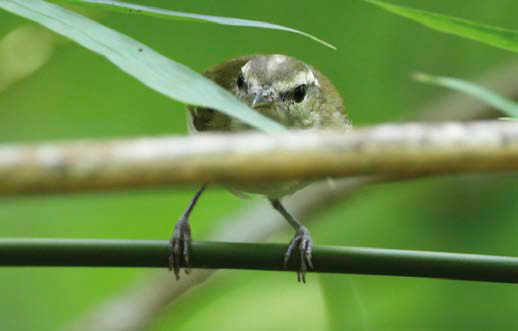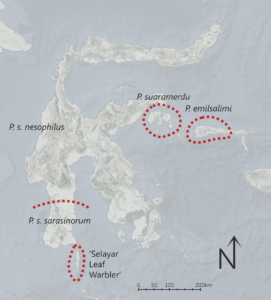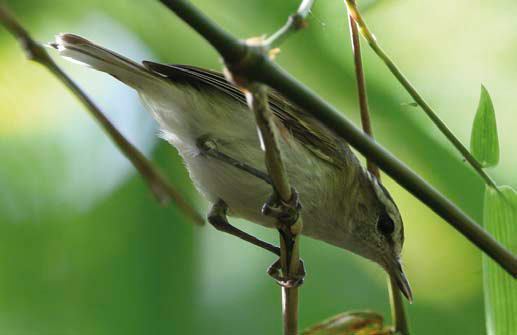
Selayar Leaf Warbler by James Eaton
The Birds of the World team welcomes José Luis Copete from Spain as our new science blogger.
Indonesia, with thousands of islands between the Indian and Pacific oceans, has been competing in recent years with the Andes as the region giving rise to the most undescribed bird species.
This is partly because research teams have begun exploring many of the lesser-known islands. One of the most surprising and dramatic results of such field work came with a paper by Frank Rheindt and co-authors (Rheindt et al. 2020), in which they described a total of 10 new taxa (five species and five subspecies) from the Wallacea region. The newly described species were Peleng Leaf Warbler (Phylloscopus suaramerdu), Taliabu Leaf Warbler (Phylloscopus emilsalimi), Taliabu Grasshopper Warbler (Locustella portenta), Taliabu Myzomela (Myzomela wahe), and Peleng Fantail (Rhipidura habibiei), all of which inhabit montane forest. Thus, an impressive five new species were discovered in 2013 and 2014 on just two islands: Peleng and Taliabu, sites described by the authors as a ‘lost world’. This was remarkable news considering that globally, the rate of new bird species described per year had been on the order of 5-6 in the last two decades, yet these unexpected finds were collected in a single 6-week expedition on just two islands, integrating genomic and phenotypic research with arduous fieldwork in remote regions.
Two of the new species were leaf warblers (Phylloscopus). Leaf warblers are a family characterized by small birds differing only subtly in plumage and morphometrics, but showing more significant differences in song and genetics. A population that colonizes a new area, such as a island, may over time acquire genetic differences, or over time the vocalizations of the new population may begin to diverge from those of its ancestors. If geographic variation in songs arise, these differences can make it more difficult for birds to recognize these variations as belonging to conspecifics. In these circumstances, birds isolated in these islands can develop a genetic divergence at the same time they develop new songs as a result of cultural mutation. Over time, the ancestral population developed a new song, viewed as unique both to conspecifics on the island and to researchers exploring there.

This was the key that allowed James Eaton, who spent time in 2017 exploring another small island, Selayar, to detect a (potentially new) leaf warbler species. On 30 November 2017, Eaton discovered a singing Phylloscopus warbler in an area of mixed second-growth forest. He noted its unique plumage and different song compared to other Wallacean leaf warblers (Eaton and Rheindt 2017), however, he could not obtain recordings of the song, because the bird only sang for a short period. This prompted a new visit to the island in January 2020 by Alex J. Berryman, who found at least six different individuals showing the same plumage traits as the bird found by Eaton in 2017. Berryman obtained good sound recordings from four of the birds, documenting the songs to be simpler, with no rambling or squeaky quality to its strophes when compared with the closest taxa in its range, the two subspecies of Sulawesi Leaf Warbler (Phylloscopus sarasinorum).
These new data add support to the idea that the leaf warbler on Selayar is yet another undescribed species, which remains to be formally given a scientific name.


During this fieldwork, Berryman also obtained more sound recordings of the two taxa living on Sulawesi, proposing that these be split as Lompobattang Leaf Warbler (Phylloscopus sarasinorum) and Sulawesi Leaf Warbler (P. nesophilus).
Alex Berryman was kind enough to explain how it was during his trip: “Like many recent Indonesian avian discoveries, the clue to Selayar’s endemism lies in the depth of water surrounding it. Despite lying just 16 km off Sulawesi, the strait separating the two is deep, such that they’ve never been connected, even during glacial maxima, when sea-levels in the region were 120 m lower than they are currently – it is this fact that led James to Selayar in the first place, when he observed a single leaf warbler he instantly recognized as distinct. Three years later, and with time to kill after my plans in the region were changed last minute, James suggested I [go] – check it out and obtain any sound recordings that might help reinforce its distinctiveness compared to the neighbouring leaf warbler on Sulawesi (that we simultaneously argue in our new paper is best treated as two species). Upon arrival at the site (after a tedious 10-hour overnight bus journey!), an unremarkable, mostly cleared area of forest, I heard the unmistakeable trill of a Phylloscopus warbler, but one that was quite unlike the more complex vocalizations heard on Sulawesi – James’s suspicion that this was undescribed species was instantly realized!
We thank and congratulate James Eaton and Alex Berryman for allowing the global birding community to learn more about the leaf warblers from Sulawesi and Selayar (Berryman and Eaton 2020). Who knows what other species are still waiting to be discovered in these Indonesian islands!
This article builds on a previous blog of this discovery which links to eBird checklists of a few of the species mentioned above. All formally described species and subspecies will be added to Birds of the World following the next update to the Clements Checklist.
References:
Berryman, A. J., and J. A. Eaton (2020). Vocalisations and taxonomy of the Sulawesi Leaf Warbler Phylloscopus sarasinorum complex, including discussion of a novel undescribed taxon from Selayar, Indonesia. Forktail 36: 90-96.
Eaton, J. A., and F. E. Rheindt (2017). New avifaunal records from the Flores Sea Islands, Indonesia, including a novel Phylloscopus leaf warbler. Birding Asia 28: 97-106.
Rheindt, F. E., D. M. Prawiradilaga, H. Ashari, Suparno, C. Y. Gwee, G. W.X . Lee, M.Y . Wu, and N. S. R. Ng (2020). A lost world in Wallacea: description of a montane archipelagic avifauna. Science 367: 167-170.

Partnerships
A global alliance of nature organizations working to document the natural history of all bird species at an unprecedented scale.
















